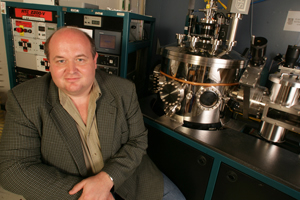A tabletop system capable of screening tens of thousands of drug candidates in an hour and a tool that can provide a foolproof cancer diagnosis with miniscule quantities of tissue obtained through non-invasive means are just two possible outcomes of research being conducted by a team of professors with the University of Houston Cullen College of Engineering.
The research team, which has received more than $1 million in grants from the National Institutes of Health and the Alliance for NanoHealth, is led by Dmitri Litvinov, associate professor of electrical and computer engineering and of chemical and biomolecular engineering. Richard Willson, professor of chemical engineering and biochemical and biophysical sciences, and John Wolfe, professor of electrical and computer engineering, serve as co-investigators for the project.
Together, they are developing versatile technology that will enable, among other things, rapid evaluation of the effectiveness of potential antiviral drugs by their ability to block a virus’ bond with a cell receptor, and high-precision detection of cancer biomarkers using molecular binding as a means for biorecognition. While it is common to utilize these natural molecular binding processes to identify biological agents, Litvinov’s research distinguishes itself by how these processes are detected.
Usually scientists attach tags, also referred to as labels, to biomolecules (proteins, DNAs, or RNAs) that allow these biomolecules to be tracked. This tracking tells researchers the location of the biomolecules, and specifically whether the biomolecules have bonded with a specific substrate, for example, a healthy cell. A common type of tag used by researchers, for example, are fluorescent beads that are detectable by their coloring.
“Many of the tags currently used in research are much larger than the biomolecules being studied,” said Litvinov. “Because of this, these tags often interfere with the formation of bonds. This complicates research and brings into question the accuracy of experiments.”
In Litvinov’s research, the tags are magnetic spheres measuring about 50 nm, 1000-times smaller than the width of human hair. As such a size, they better conform to the size of the biomolecules to which they are attached, thereby minimizing their interference with the binding processes.
While these spheres have already been developed and are available to scientists, their small size makes them extremely difficult to track and detect, however.
Litvinov, Willson and Wolfe, therefore, are developing an array of magnetic-field sensors capable of detecting the presence of these magnetic spheres. These sensors, dubbed giant magnetoresistive (GMR) sensors, are widely used in the data storage industry and are small enough that a million of them can be fit in a single square millimeter of space.
For applications in antiviral drug development, these sensors will be coated with cell receptors that bind with a specific virus protein. When the virus protein bonds with the cell receptor, the GMR sensors will detect magnetic spheres, letting researchers know that bond has occurred.
Should an antiviral drug be added to the mix, it will block the cell receptors, preventing them from binding with the virus protein.
It is this process that will enable Litvinov’s tool to screen potential drug candidates. By adding potential medications to a mixture containing viruses, the GMR sensor array will, in effect, detect whether a drug blocks a particular virus from binding with a cell receptor. If it does, further clinical trials with the drug will likely follow.
Because so many sensors can reside in a small area, hundreds, even thousands of drug candidates can be screened at once, cutting down the time it takes to bring new drugs to market.
In addition to testing the viability of potential drug candidates, the technology being developed by Litvinov’s team may also be put to use in other areas of health care.
“Though this technology is initially funded for drug development, it can be used for other high-throughput molecular screening applications, such as in cancer studies,” said Litvinov.
Such an application would work in a similar way as the tests for potential drug candidates. A small biological sample suspected of being cancerous would be extracted from a patient using a nearly painless technique, fine needle aspiration. This sample would be placed in a solution that contains tags that bind only with cancer biomarkers, while the GMR sensors would be coated with a biological material that also bonds with the biomarkers. If these biomarkers are present they will act as intermediaries to bond the tags and the GMR sensors. Should this bonding occur, the sensor will detect the tags, indicating without a doubt the presence of cancerous cells.
The key advantage of such a system, said Litvinov, is that it would be combines the non-invasive nature of fine needle aspiration with the reliability of conventional highly invasive techniques, such as open surgery.
“The way they evaluate fine needle aspiration biopsies for the presence of cancer is by looking at [a biological sample] under a microscope, which relies heavily on the experience of the person evaluating the sample and the quality of the sample” he said. “Here, the idea is to automate the process to make it foolproof and eliminate the human-error factor without resorting to surgery.”
Whether used as a diagnostic tool or to screen drug candidates, the use of GMR sensors in medical applications has the potential to simplify many areas of medical research. Litvinov and his team are confident that they can turn this potential into a reality.
